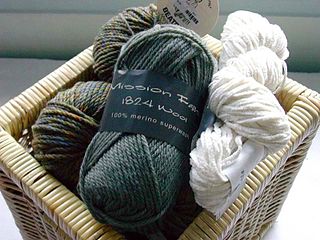
Yarn is a long continuous length of interlocked fibres, suitable for use in the production of textiles, sewing, crocheting, knitting, weaving, embroidery, or ropemaking. Thread is a type of yarn intended for sewing by hand or machine. Modern manufactured sewing threads may be finished with wax or other lubricants to withstand the stresses involved in sewing. Embroidery threads are yarns specifically designed for needlework.

A blanket is a piece of soft cloth large enough either to cover or to enfold a great portion of the user's body, usually when sleeping or otherwise at rest, thereby trapping radiant bodily heat that otherwise would be lost through convection, and so keeping the body warm.

Glen Williams is a hamlet in the Credit River valley in the province of Ontario, Canada. It is part of Halton Hills in the Halton Regional Municipality. Glen Williams is home to many visual artists, contains a collection of artist’s studios and is a major draw to the area. Glen Williams has a compact community core that includes commercial uses, a restaurant and bakery, a community centre, parks, churches and homes. The character of the hamlet of Glen Williams is largely defined by the heritage buildings, which help give Glen Williams its distinctive look and feel. These buildings help create an environment that is distinctive and lays the foundation for a cohesive community. The Credit River which flow through the village extends over 1,500 km (930 mi) from the Niagara Escarpment, emptying into Lake Ontario at Port Credit, Mississauga. Glen Williams is also home to many species of birds, mammals and fish, with the river providing an exemplary habitat for them.

Willamette Heritage Center is a museum in Salem, Oregon, United States. The 5-acre site features several structures listed on the National Register of Historic Places including the Thomas Kay woolen mill, the Jason Lee House, Methodist Parsonage, John D. Boon House and the Pleasant Grove (Condit) Church. The houses and church were relocated to the mill site. The Center also includes a research library and archives of Marion County history.

Watkins Mill, in Lawson, Missouri, is a preserved woolen mill dating to the mid-19th century. The mill is protected as Watkins Woolen Mill State Historic Site, which preserve its machinery and business records in addition to the building itself. It was designated a National Historic Landmark and added to the National Register of Historic Places in 1966 in recognition for its remarkable state of preservation. The historic site is the centerpiece of Watkins Mill State Park, which is managed by the Missouri Department of Natural Resources.

The Northwestern Knitting Company Factory, also known as Munsingwear Corporation and later as International Market Square, is a former factory building in the Sumner-Glenwood neighborhood of Minneapolis, Minnesota, United States. The company was founded in 1888 by George D. Munsing, who invented a method of plating wool fibers with silk and cotton to make the union suit more comfortable. The company received financial backing from Clinton Morrison and Charles Alfred Pillsbury, who were prominent businessmen in the Minneapolis flour milling industry. This style of underwear, patented in 1891, proved to be very popular, and the company eventually became the world's largest manufacturer of underwear. The company changed its name in 1919 to Munsingwear.

The Union Mill Complex,, is located at the junction of Milton Avenue and Prospect Street in Ballston Spa, New York, United States. It is a complex of three late 19th-century brick buildings on a 4-acre lot, and the ruins of a dam.
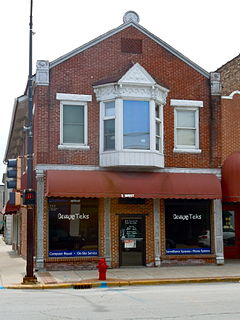
The Stolp Woolen Mill Store was built in 1860. It is located on Stolp Island in Aurora, Illinois. It was listed on the National Register of Historic Places in 1983. It is also a contributing building in the Stolp Island Historic District.

Stanley Woolen Mill is the common historic name applied to a defunct company based in southeastern Massachusetts and to the company's buildings which stand at the southern entrance to the Blackstone River and Canal Heritage State Park. The mill is an important footnote in the history of the textile industry in America. Stanley Woolen Mill is the centerpiece of the Central Woolen Mills District which is part of the National Historic Register.
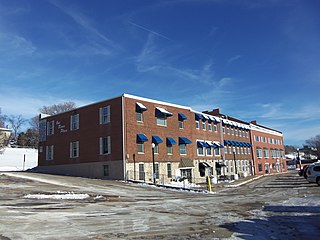
Shields Woolen Mill is located along the edge of the Mississippi River in Davenport, Iowa, United States. It has been listed on the National Register of Historic Places since 1983. The building has been repurposed as commercial and office space.
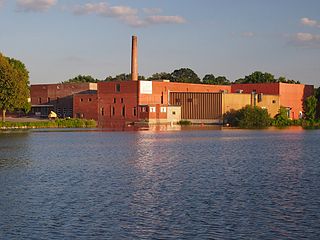
The Faribault Woolen Mill Company is a textile manufacturing company in Faribault, Minnesota, United States, that produces and sells wool blankets and other woolen products. Its products included ingeo, cotton, acrylic and wool bed blankets, pillows, mattresses, pads, and baby blankets, and wool, ingeo and blend throws. The company primarily serves various enterprise sectors. It offers its products through its store in Faribault and nationwide through retailers.

Mississippi Mills was a cotton and wool textile manufacturing complex that operated in Wesson, Mississippi, during the latter half of the 19th century. By 1892, Mississippi Mills was described as the largest industry of its kind in the South.
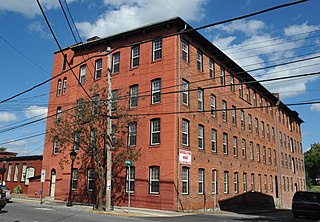
Kitson Woolen Mill, also known as the Holland Thread Company building, is a historic woolen mill complex located at Stroudsburg, Monroe County, Pennsylvania. The complex consists of four brick buildings built between 1893 and 1904. They are arranged in a "U"-shape and consist of the "East Wing," "West Wing," boiler house, and office. The Kitson Woolen Mill was in operation until 1928, after which the mill was occupied by the Holland Thread Company until 1978.

The Winooski Falls Mill District is located along the Winooski River in the cities of Winooski and Burlington, Vermont, in the United States of America. It encompasses a major industrial area that developed around two sets of falls on the river in the 19th century.
Blarney Woollen Mills was built in 1823. It was used mainly for spinning and weaving wool. The mill briefly closed for two years between 1973 and 1975, after which it was re-opened as an Irish heritage shop. It is located in the village of Blarney, County Cork, Ireland.

The Portland Woolen Mills were a wool textile manufacturer in the St. Johns neighborhood of Portland, Oregon. By 1950, they had become the largest wool manufacturer west of Cleveland, Ohio. The origins of the factory started in Sellwood in 1901 but after a fire destroyed the mill two years later owners decided to rebuild in St. Johns. Portland Woolen Mills offered several worker programs including baseball, basketball and bowling teams; a cafeteria and a library.

The Busiel-Seeburg Mill is a historic mill building at 1 Mill Plaza in Laconia, New Hampshire. This 3-1/2 story brick structure achieved its present configuration in stages, beginning in 1853, and successively altered and expanded through the rest of the 19th century. The business, established by John W. Busiel in 1846, manufactured knitted hosiery, and was one of the first producers of knitwear to use circular knitting machines invented by Aiken and Peppers. The building was listed on the National Register of Historic Places in 1971.

Hollar Hosiery Mills-Knit Sox Knitting Mills is a historic knitting mill located at Hickory, Catawba County, North Carolina. It consists of two mill brick manufacturing buildings and a boiler house that were connected by a hyphen in the mid-1960s. The first mill building was built about 1930, and is a one- to two-story, 16 bay, brick veneer structure. The boiler house was also built about 1930, and is a small, brick building, with its flat roof and terra cotta coping. The hosiery yarn mill was built about 1940, and is two-story, six bay by 10 bay, brick-veneered building. Both mill buildings feature banks of steel-sash factory windows. The knitting mill operated until 1968.

The American Woolen Company Foxcroft Mill or Mayo & Son Woolen Mill is a group of seven historic buildings and three structures on East Main Street in downtown Dover-Foxcroft, Maine. The district is located on 2.77 acres (1.12 ha). The Foxcroft Mill is located on the west side of the Piscataquis River, which flows through downtown Dover-Foxcroft. The buildings were built between 1844 and 1941, and have been listed on the National Register of Historic Places.

The Conley–Maass Building, also called the Maass and McAndrew Company Building, is one of the oldest remaining places of business in Rochester, Minnesota. Originally built as a woolen mill, it was the site of Conley Camera Company from 1904 to 1909. As such, it appeared in several Sears catalogs. Maass & McAndrew Plumbing and Heating occupied the building from 1910 to 1955. It has also housed the Fraternal Order of Eagles, Veterans of Foreign Wars, the Loyal Order of Moose, The Salvation Army, Rochester Ballet School, Masque Theatre, and Words Players.






























